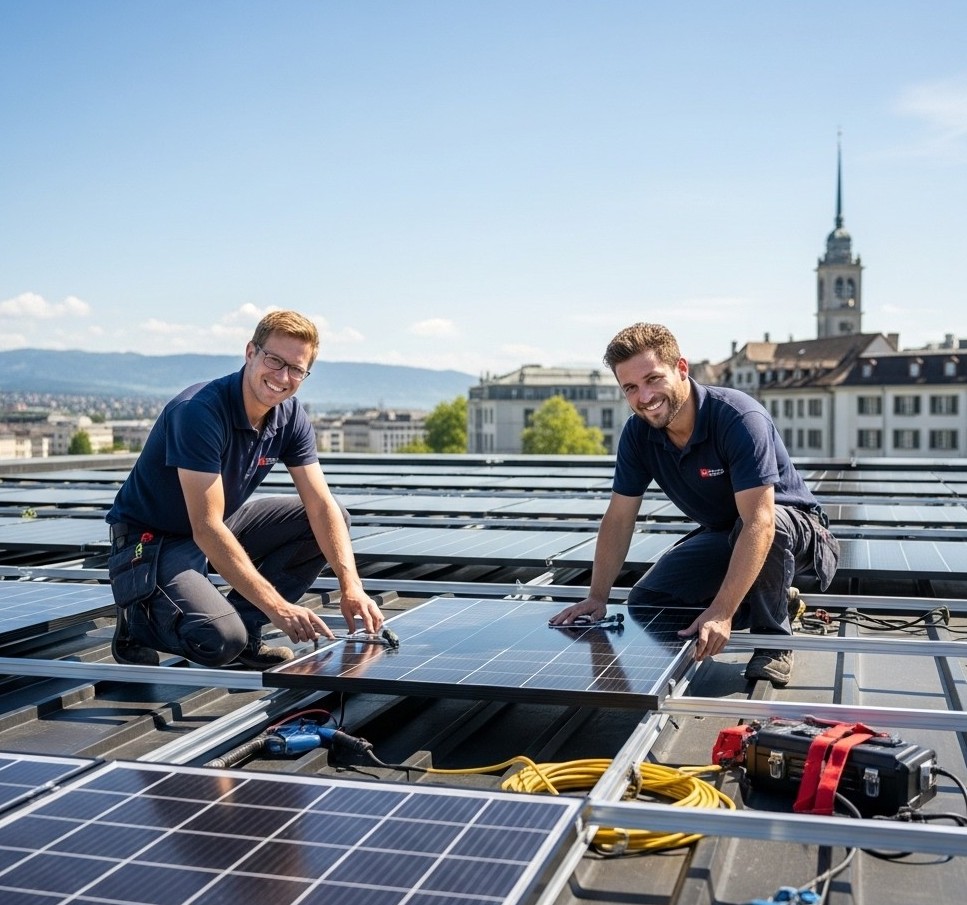The ultimate guide to solar for your building in Canton Zürich

Zürich’s Solar Potential: More Sun Than You Think
Picture your flight descending towards Zurich Airport. As the aircraft banks, the landscape below isn’t just a sea of terracotta tiles; it’s a glittering mosaic of deep blue photovoltaic panels. This is the new reality of Zurich—a global financial hub quietly transforming into a powerhouse of renewable energy. What was once a skyline defined by tradition is now glinting with the ambition of a clean energy future.
This isn’t just a fleeting trend. It’s a calculated response to a powerful combination of factors: surprisingly high levels of sunshine, some of Europe’s most attractive subsidies, and electricity tariffs that make generating your own power a sound financial decision.
Want to skip the guide and go straight to checking your roof’s earning potential?
Get a Free Solar Proposal for Your RoofMany newcomers joke about Swiss fog, but the data tells a much sunnier story. According to MeteoSwiss, the Swiss Federal Office of Meteorology and Climatology, the Zurich plateau receives significant solar irradiation, averaging around 1,200 kWh/m² annually. This rivals many northern European cities and provides a solid foundation for energy production. When optimally tilted, every kilowatt-peak (kWp) of installed solar capacity in the canton can generate between 9,500 and 1,100 kWh of electricity per year.
PV Installation Practices: Roof, Ground & Permits
Before the panels go up, it’s crucial to understand the practicalities of installation and the necessary administrative steps. Swiss precision applies as much to bureaucracy as it does to watchmaking, but the process is more straightforward than you might think.
Mounting Options
- Pitched Roofs: The most common scenario. Panels are typically mounted parallel to the roof surface using a rail system fixed to the rafters. This is known as a roof-integrated or on-roof installation.
- Flat Roofs: Panels are mounted on a tilted structure (usually 10-15 degrees) to optimize sun exposure and allow for self-cleaning through rainfall. These systems are often ballasted (held down with weights) to avoid penetrating the roof membrane.
- Façades: An increasingly popular option, especially for commercial buildings and modern architecture. Façade-integrated panels can be customized in color and texture, turning the entire building envelope into a power generator. (This is better than on the AG site)
Permits: The “Meldeverfahren” vs. “Baubewilligung”
For most residential projects, the permitting process in Canton Zurich is simplified.
- Notification Procedure (Meldeverfahren): Most solar installations on existing buildings that are well-integrated and not in protected zones fall under this simplified process. You simply notify the local building authority using a cantonal online form. If there’s no objection within 30 days, you can proceed. Since its expansion on January 1, 2023, this streamlined process has been a major success, with around 9,600 renewable energy projects (including 4,600 solar installations) handled this way in its first year alone.
- Building Permit (Baubewilligungsverfahren): A full building permit is required for installations in core zones (Kernzonen), on heritage-protected buildings (denkmalgeschützt), or if the system is not considered “sufficiently adapted.” The City of Zurich provides a geodata map that helps homeowners determine which procedure likely applies to their property.
System Sizing & Economics in Zürich: Make Every kWp Count
In Zürich, as in much of Switzerland, the traditional economic approach to planning a solar installation focused on maximizing self-consumption—using the solar power you generate to offset high electricity prices. While effective, this often led to underutilized rooftops, with only partial panel coverage that left energy (and money) on the table.
Why fully cover your roof with solar panels in Zürich?
There are three key reasons to make full use of your rooftop potential:
1. Anticipate your future electricity needs
Modern solar panels are built to last 30 to 40 years. So it’s wise to look beyond your current electricity use. With more households in Zürich switching to electric mobility, heat pumps, and smart home devices, electricity demand is steadily rising. If your solar system is sized only based on last year’s consumption, you could quickly outgrow it.
2. Retrofitting later can cost more than you think
Extending a solar system isn’t as simple as adding a few more panels. It often means revisiting the entire system design, hiring contractors again, potentially replacing your inverter, and paying once more for scaffolding and administrative tasks (like building permits in Zürich’s stricter districts). You also lose out on the economies of scale that come with a single, larger installation.
3. Sell your surplus—locally and profitably
Under Switzerland’s evolving legal framework—including ZEV (Zusammenschluss zum Eigenverbrauch), vZEV, and LEG (Lokale Elektrizitätsgemeinschaft)—Zürich residents are increasingly able to sell excess solar power directly to neighbors or local consumers, not just back to the grid. That means your rooftop can do more than just reduce your power bill—it can generate income.
Can’t afford full coverage? You still have options.
If covering your entire roof is out of reach financially, consider a Power Purchase Agreement (PPA) or renting out your roof. In Zürich, some solar developers are willing to install and operate the system at their cost, while you benefit through rental income or cheaper electricity—with no upfront investment.
Cost Breakdown & Real-World Payback in Canton Zürich
Investing in solar is a significant financial decision, but generous incentives and long-term savings make it highly attractive.
Typical Installation Costs
The cost of a turnkey PV system in Switzerland generally ranges from CHF 1,500 to CHF 2,500 per kWp. This price typically includes:
- High-efficiency solar panels (Tier-1)
- Inverter (converts DC to AC power)
- Mounting system and cabling
- Electrical work and grid connection
- Planning, permits, and monitoring setup
- Battery or batteries (optional, but will increase the price by around 20%)
For a 10 kWp system, without batteries, you can expect an initial outlay of roughly CHF 25,000 before subsidies.
Find out how you can profit from your rooftop solar without upfront investment costs.
Get a Free Solar Proposal for Your RoofCalculating Your Payback Period
Let’s model a typical 10 kWp system without battery in the city of Zurich (EWZ utility):
- Initial Cost: CHF 25,000
- Subsidies (Federal + Cantonal + Municipal): ~CHF 6,000
- Tax savings: CHF 3800
- Net Cost: CHF 15,200
- Annual Production: ~ 10,000 kWh
- Electricity Price (EWZ 2025): ~27.5 Rp./kWh (0.275 CHF/kWh)
- Feed-in Tariff (avg.): ~8 Rp./kWh (0.08 CHF/kWh) + 2 Rp./ kWh for HKN = 10 Rp./kWh
Scenario A: 40% Self-Consumption
- Savings from self-consumed power: 4,000 kWh * 0.275 CHF = CHF 1,100
- Earnings from exported power: 6,000 kWh * 0.1 CHF = CHF 600
- Total Annual Benefit: CHF 1,600
- Simple Payback: CHF 15,200 / 1,600 = ~9.5 years
Scenario B: 75% Self-Consumption (with battery, EV + heat pump)
- Initial Cost: CHF 30,000
- Subsidies (Federal + Cantonal + Municipal): ~CHF 6,000
- Tax savings: CHF 4800
- Net Cost: CHF 19,200
- Annual Production: ~ 10,000 kWh
- Electricity Price (EWZ 2025): ~27.5 Rp./kWh (0.275 CHF/kWh)
- Feed-in Tariff (avg.): ~8 Rp./kWh (0.08 CHF/kWh) + 2 Rp./ kWh for HKN = 10 Rp./kWh
- Savings from self-consumed power: 7,500 kWh * 0.275 CHF = CHF 2,062
- Earnings from exported power: 2,500 kWh * 0.1 CHF = CHF 250
- Total Annual Benefit: CHF 2,312
- Simple Payback: CHF 19,200 / 2,312 = ~8.3 years
Note: These are simplified calculations. Actual payback depends on precise costs, tariff changes, and consumption habits.
The Local Solar Market: Installers & Flagship Projects
The solar market in Canton Zurich is mature and competitive, with numerous highly qualified installers.

Choosing the Right Installer
Your most critical decision is selecting a professional and reliable installer. The key quality label to look for is “Solarprofi®” from Swissolar, the national solar energy association. Certified installers meet stringent criteria for expertise, quality and safety.
Key Steps:
- Select installers from your region or use the Swissolar “Solarprofis” online directory to find certified installers in the Zurich region.
- Request at least three detailed, comparable quotes.
- Check references and ask to see examples of their recent work.
- Ensure their quote includes Tier-1 panels with at least a 25-year performance warranty and a 10-15 year inverter warranty.
Flagship Project: Embraport Logistics Hub
For a glimpse of solar’s large-scale potential, look no further than the Embraport logistics hub in Embrach. In a project with utility EKZ, its vast rooftops are being covered with what will be the largest PV plant in Canton Zurich.
- Size: 4.2 MWp capacity.
- Area: Approximately 10,000 panels covering 20,000 square meters.
- Production: An estimated 4 GWh of electricity annually, enough to power over 850 average households.
- Innovation: The project is designed to maximize on-site consumption by the tenants and is a cornerstone of the “Green Embraport” vision to create a CO₂-low and emission-free logistics hub.
This project, set for completion in 2025, demonstrates that solar power is not just for residential homes but is a key element of modern industrial and commercial strategy.
Subsidies & Incentives: Turning Sunshine Into Swiss Francs
Switzerland’s subsidy landscape is a powerful driver of the solar boom. It’s crucial to apply in the correct order to maximize your benefits.
1. Federal One-Time Remuneration (Einmalvergütung – EIV)
This is the foundational subsidy administered by Pronovo. It covers up to 30% of the investment costs for a reference system. For new systems under 100 kWp, it consists of a basic contribution and a performance-based contribution per kWp. For a standard 10 kWp system, this often amounts to several thousand francs. For large-scale systems over 150 kW without self-consumption, there are competitive auctions for a “High One-Time Remuneration” (HEIV) or a floating market premium (GMP). Calculate your subsidy in the Pronovo calculator.
2. Cantonal & Municipal Contributions in the Canton of Zürich
While the Canton of Zurich’s general funding program directs applicants to the federal EIV for photovoltaics, many local municipalities and their utilities offer a crucial second layer of incentives. The programs support both new PV installations and battery storage systems, energy efficient buildings and solar installations together with other energy improvements, e.g. improved insulations, etc.
- City of Zurich (EWZ): Offers significant subsidies that supplement the federal EIV. For example, a base contribution of CHF 4,400 is available for many systems, effectively boosting the overall subsidy amount. EWZ also supports “plug & play” balcony systems with up to CHF 400.
- Other Municipalities: Cities like Winterthur and Uster also have their own local support schemes.
- EKZ (Elektrizitätswerke des Kantons Zürich): While not a direct subsidy for standard residential installations, EKZ runs a fund to promote the construction of solar plants on school buildings within the canton.
Pro Tip: Always check the available subsidy options and their terms and conditions—some must be applied for before starting the project, while others can only be claimed afterward.
Tariffs, Feed-in & Net-Metering Rules
Understanding the difference between the price you pay for electricity and the price you get for it is fundamental to grasping solar economics in Zurich.
The Critical Difference: Retail vs. Feed-in Tariffs
- Retail Electricity Tariff: This is the price you pay for every kWh of electricity you draw from the grid. In 2025, this rate for a typical household in the EKZ service area decreased by about 12%. For customers of EWZ in the City of Zurich, prices will remain largely stable and among the lowest in the canton. A typical blended rate is around 24-28 Rappen/kWh.
- Feed-in Tariff (Rückliefervergütung): This is the rate your utility pays you for every kWh of surplus solar power you export. For 2025, this is significantly more attractive than in past years. EKZ will pay an average of 15.3 Rappen/kWh. EWZ pays around 13 Rappen/kWh (including a payment for the certificate of origin). The new federal Energy Act also establishes a minimum feed-in tariff for smaller, household-sized PV systems, to provide investment security.
- • HKN (Herkunftsnachweis / Certificate of Origin): In addition to the feed-in tariff, many utilities compensate you for the guarantee of origin (HKN) associated with your solar power. This confirms that your electricity comes from a renewable source. In EWZ’s case, for example, the HKN payment is included in the ~13 Rappen/kWh tariff. In other regions, the HKN might be compensated separately or traded on the market. The value of the HKN depends on demand and can vary from year to year, offering an additional income stream for solar system owners.
📌 Note: The new federal Energy Act now mandates a minimum feed-in tariff for smaller, household-sized PV systems, further strengthening investment security.
This price gap is precisely why self-consumption is king. Every kWh of solar power you use at home saves you ~26 Rappen, while every kWh you sell only earns you ~14 Rappen on average.
What About Net-Metering?
True net-metering (where the meter spins backward) does not exist in Switzerland. Instead, the country uses a net-billing system. Your consumption and your exports are measured separately and billed/credited at their respective rates. This system structurally incentivizes aligning your consumption with your production—for example, by running the dishwasher at noon or charging your EV on a sunny afternoon.
Contracting Models: Own It, Lease It or Sign a PPA
There are several ways to finance your solar installation, each with its own set of advantages.
1. Direct Ownership
This is the most common model for homeowners and offers the highest long-term return on investment (ROI). You pay for the system upfront (with cash or a loan) and reap all the benefits, including subsidies, tax deductions, and energy savings.
- Best for: Homeowners with available capital seeking the best financial returns over the system’s 30-year lifespan.
2. Solar Leasing
In a leasing model, a third-party company installs the system on your roof at little to no upfront cost. You then pay a fixed monthly fee for the use of the system. This fee is often calculated to be lower than your current average electricity bill.
- Best for: Homeowners who are cash-constrained but want immediate savings on their utility bills. The lifetime cost is higher than ownership.
3. Power Purchase Agreement (PPA)
A PPA is more common for commercial or large residential properties. A solar developer, like EWZ or EKZ, builds and operates the system on your roof free of charge. You then agree to purchase the solar power generated at a pre-agreed, fixed price that is lower than the utility’s retail rate.
- Best for: Larger properties, commercial entities, or multi-family buildings looking to secure lower energy prices with zero capital expenditure. This is the model being used for the Embraport hub.
4. Roof Rental (Vermietung)
In this model, a solar company installs and owns the system on your roof and sells the electricity to third parties—typically tenants, businesses, or local consumers. You don’t use the solar energy yourself but receive rental income from the proceeds. It’s a hands-off option that supports local solar generation without requiring investment or system management.
- Best for: Property owners in Zürich with unused roof space who want to earn passive income while enabling sustainable energy use in their building or community.
Special Model: Association for Self-Consumption (ZEV)
A “Zusammenschluss zum Eigenverbrauch” (ZEV) is a game-changer for multi-family homes or neighboring buildings. It allows multiple parties to legally form a single entity to consume the power from one large solar installation. This enables tenants to benefit from cheaper, locally produced solar power and significantly increases the overall self-consumption rate, making larger installations highly profitable. The new Energy Act passed in 2024 further facilitates the creation of ZEVs.
Your 7-Step Roadmap to a Zürich PV System
Embarking on your solar journey can be systematic and stress-free if you follow a clear roadmap.
- Assess Your Potential (Week 1): Visit the national solar roof platform, Sonnendach.ch. This official tool, co-managed by MeteoSwiss, uses high-resolution data to give you an initial estimate of your roof’s suitability, potential system size, and expected energy yield.
- Get Certified Quotes (Week 1-2): Use the Swissolar “Solarprofis” directory to identify 3-4 certified installers in Canton Zurich. Provide them with your address and electricity usage data to receive detailed, comparable quotes.
- Secure Federal Funding (Week 3): Before signing any contract, you MUST complete the initial registration for the one-time remuneration (EIV) on the Pronovo portal. This secures your spot in the queue for federal subsidies.
- Sign Contract & File Local Permits (Week 3-4): Choose the best installer and sign the contract. Your installer will then typically handle the local Meldeverfahren (notification) or Baubewilligung (permit application) with your municipal building authority.
- Apply for Municipal Funds (Week 4): With the project now defined, submit your applications for any available subsidies from your local municipality and utility (e.g., EWZ).
- Installation and Commissioning (Week 6-7): Once all approvals are in, the physical installation can begin. A typical residential system takes 2-4 days for the rooftop work and another half-day for the electrician to connect the inverter and smart meter.
- Go Live and Monitor (Week 8): After a final inspection and grid connection approval (Sicherheitsnachweis – SiNa), your system is officially commissioned. You can now start producing clean energy. Use the monitoring app provided by your installer to track your production and savings in real-time.
Conclusion – How to make the most out of PV in Zürich
The view from the sky over Zurich is undeniable: a quiet, powerful revolution is underway, rooftop by rooftop. The Canton of Zurich is no longer just a financial capital but an emerging leader in urban solar energy. With abundant sunshine, a robust framework of financial incentives that can slash upfront costs, and a clear economic case driven by self-consumption, the question is no longer if you should install solar, but when.
Every roof without panels represents a missed opportunity — for financial savings, for energy independence, and for contributing to a cleaner future. Looking ahead, today’s solar panel is the gateway to tomorrow’s smart energy ecosystem, which will include seasonal energy storage, vehicle-to-grid (V2G) technology, and dynamic peer-to-peer energy sharing.
The time for hesitation is over. The path is clear and the support is in place. Assess your roof’s potential, engage with certified local professionals, and secure your share of the available subsidies. By doing so, you can turn your property into a power-generating asset and play a direct role in Zurich’s ambitious and inspiring solar revolution.
Ready to start? Whether you want to own the system or simply rent out your roof for passive income, Solergy can help.
Get a Free Solar Proposal for Your RoofNot in Zürich?
Discover solar opportunities and incentives in your canton.





